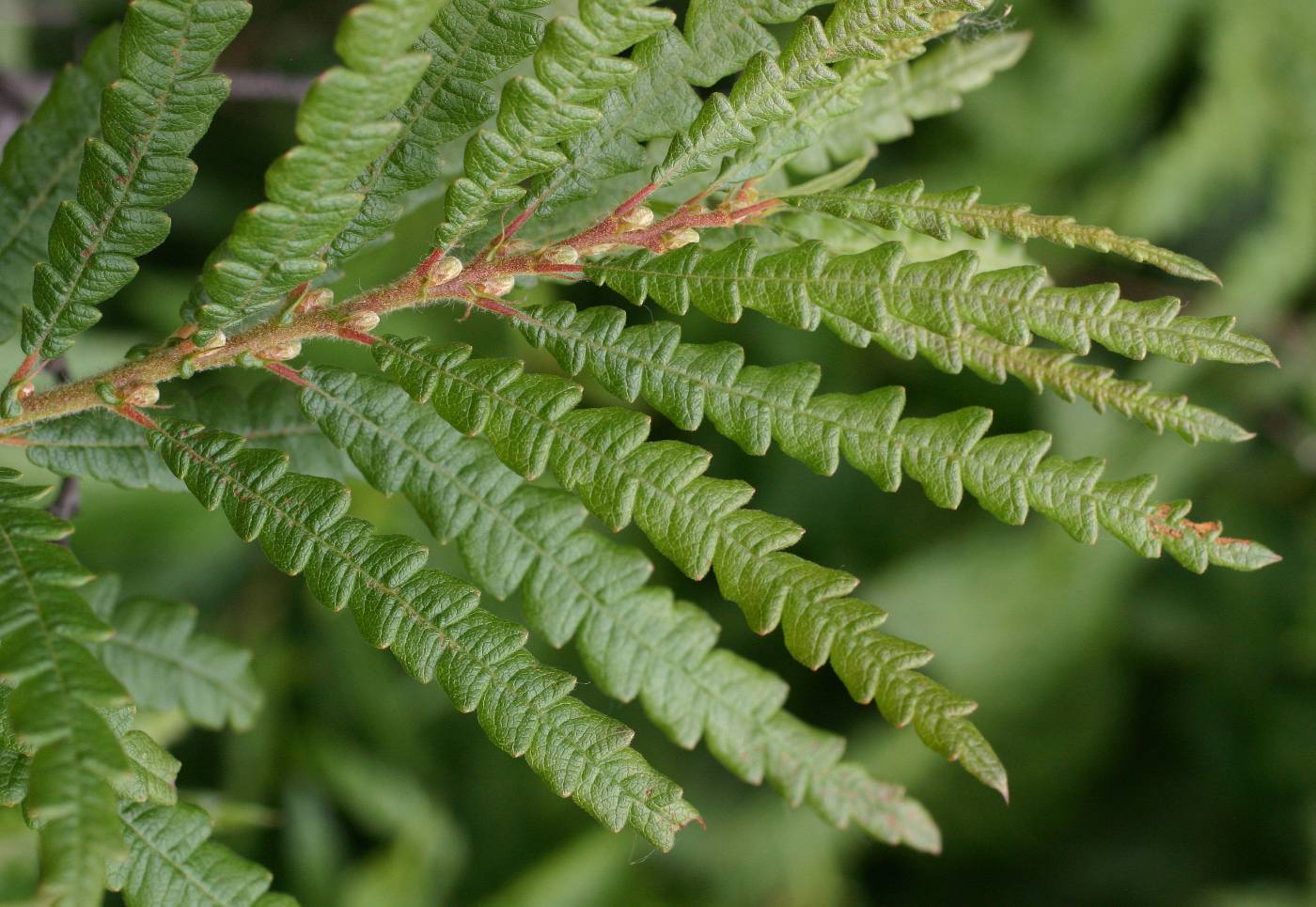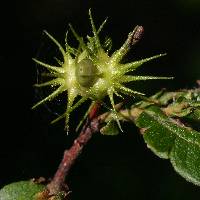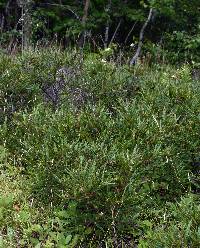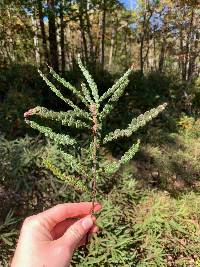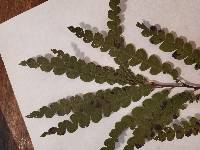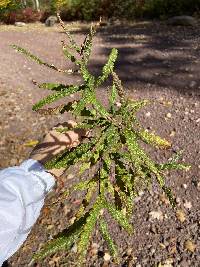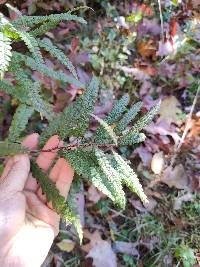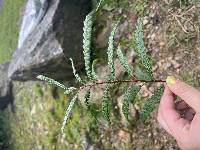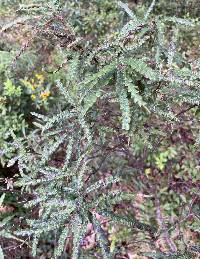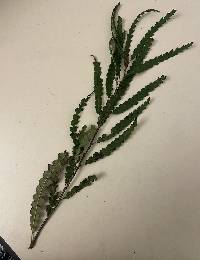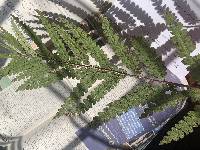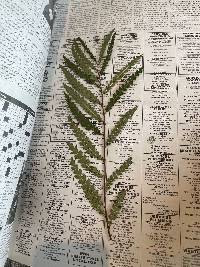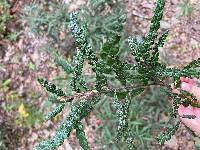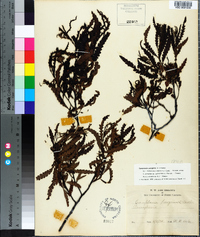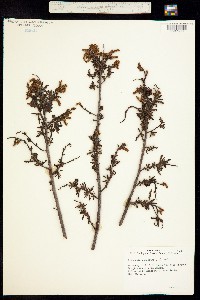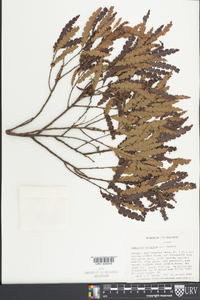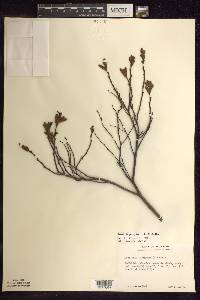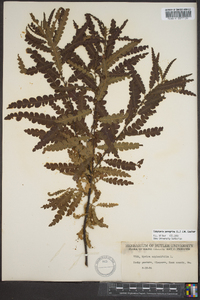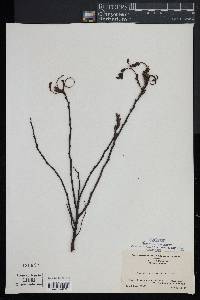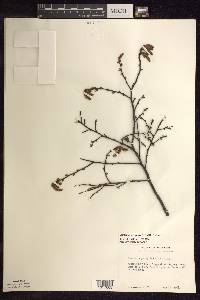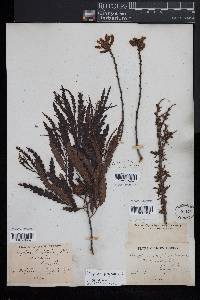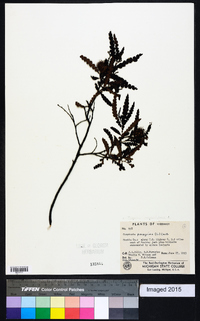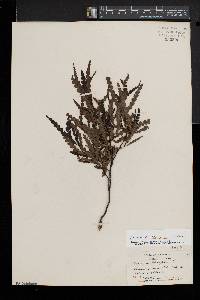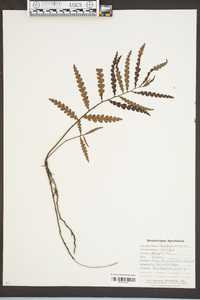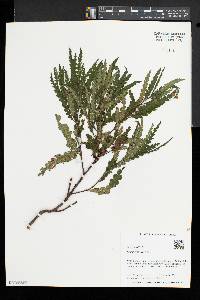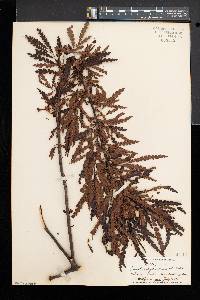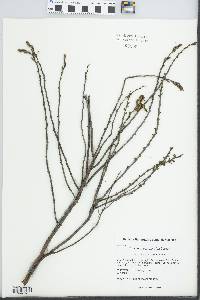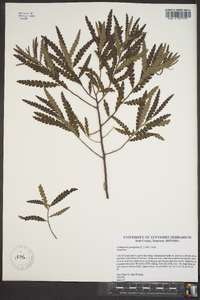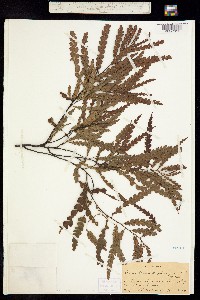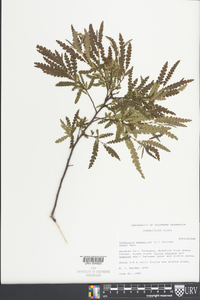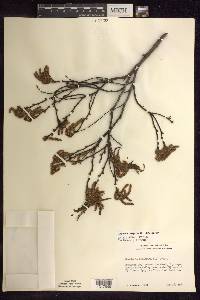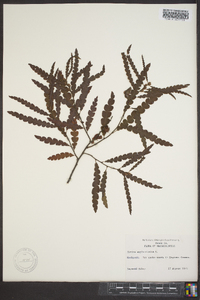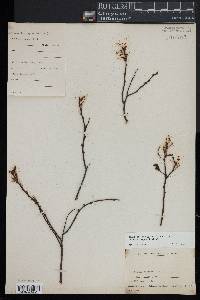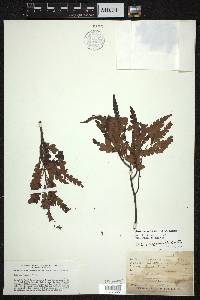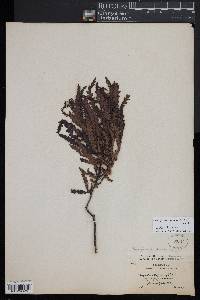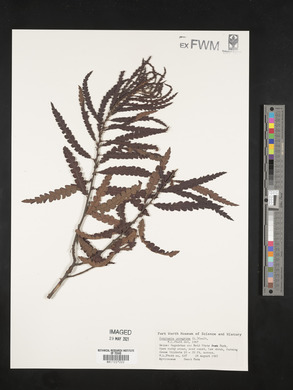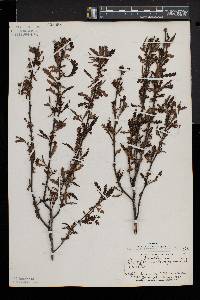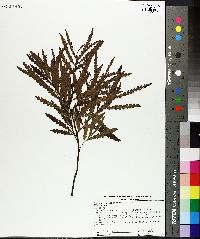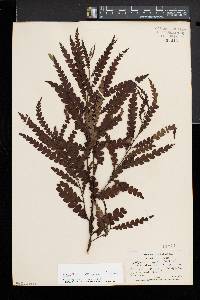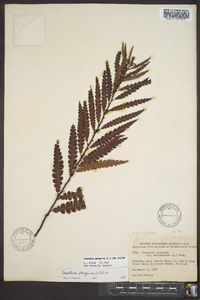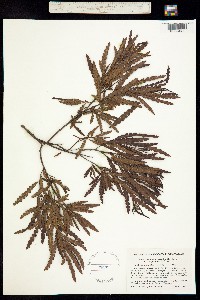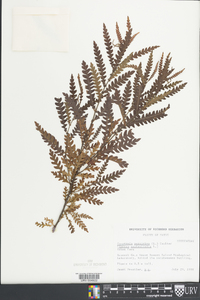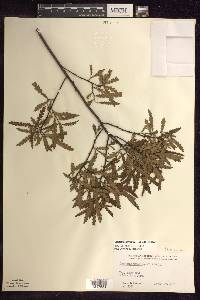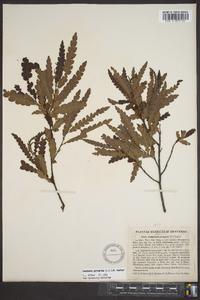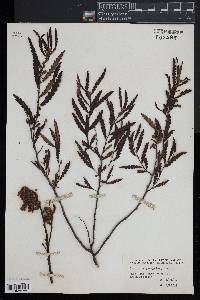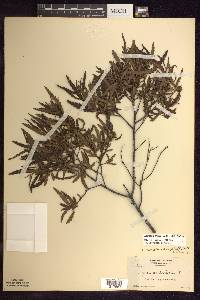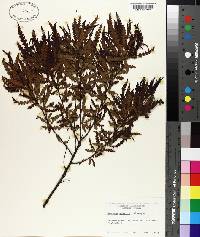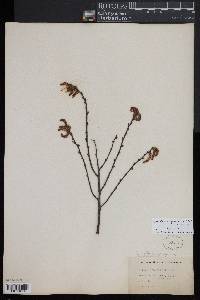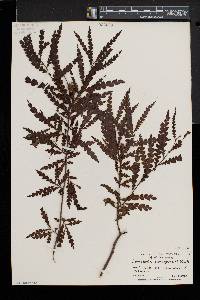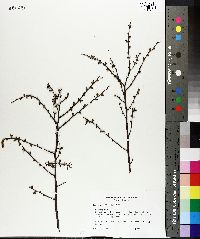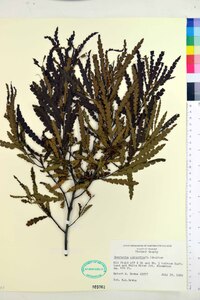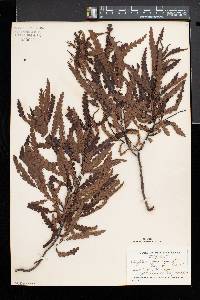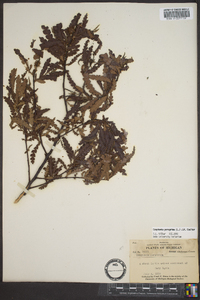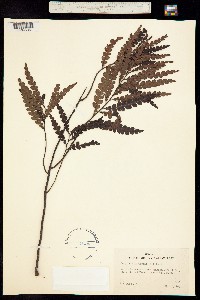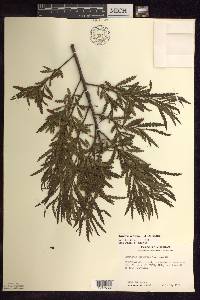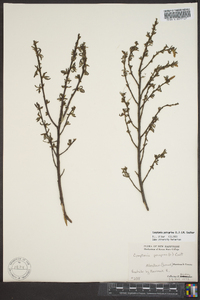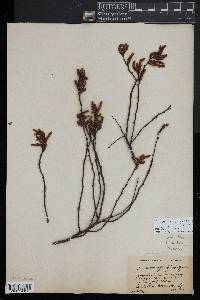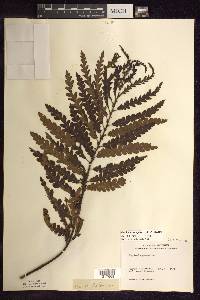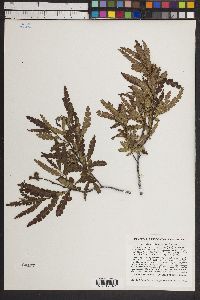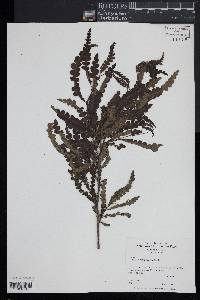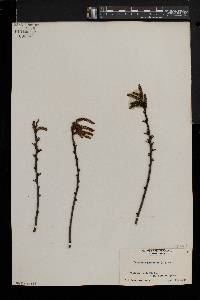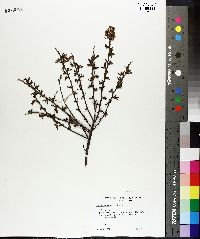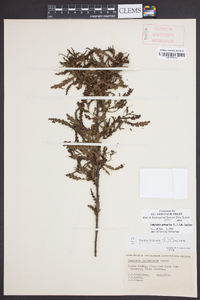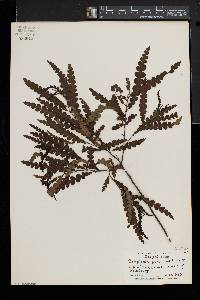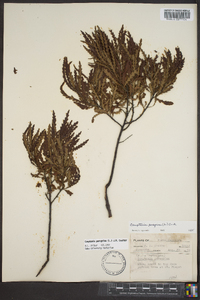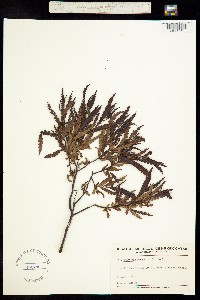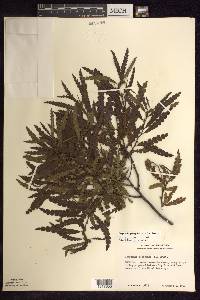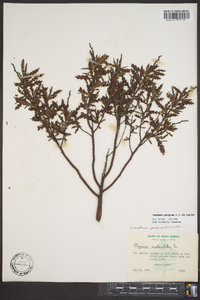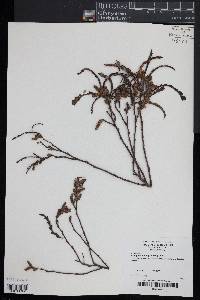Comptonia peregrina
|
|
|
|
Family: Myricaceae
Sweet-Fern
[Comptonia asplenifolia (L.) L'Hér. ex Aiton, moreComptonia peregrina var. asplenifolia , Myrica asplenifolia L.] |
Shrubs , to 1.5 m, forming rhizomatous colonies. Branchlets red-brown to gray, pilose to villose, sometimes puberulent. Leaves: stipules nearly cordate, long-acuminate. Leaf blade very aromatic when crushed, 3-15.5 × 0.3-2.9 cm, lobes alternate to nearly opposite, base truncate, cuneate to attenuate, or oblique, apex acute; surfaces abaxially pale gray-green, densely pilose to puberulent, adaxially dark green, densely pilose to glabrate, gland-dotted, especially adaxially. Inflorescences: staminate in clusters at ends of branches, elongating to 5 cm, bracts broadly ovate to trullate, margins ciliate, apex acute to long-acuminate, abaxially gland-dotted; pistillate to 5 mm at anthesis, elongating in fruit to 2 cm, bracteoles to 1.3 cm, pilose, gland-dotted. Fruits 2.5-5.5 mm. Flowering spring, fruiting summer. Dry, sterile, sandy to rocky soils in pinelands or pine barrens, clearings, or edges of woodlots; 0-1800 m; N.B., N.S., Ont., P.E.I., Que.; Conn., Del., Ga., Ill., Ind., Ky., Maine, Md., Mass., Mich., Minn., N.H., N.J., N.Y., N.C., Ohio, Pa., R.I., S.C., Vt., Va., W.Va., Wis. Comptonia peregrina has been reported from Tennessee (Scott County), but I have not seen any specimens. Many Native American tribes used different parts of Comptonia peregrina variously: as an incense for ritual ceremonies; for medicinal purposes; as a stimulant or tonic; as a food seasoning; and as a poison (D. A. Moerman 1986).
Shrub to 1.5 m tall Leaves: alternate, dark green and often shiny above, grayish green beneath, 3 - 15.5 cm long, 0.3 - 2.9 cm wide, linear, fern-like (pinnatifid), dotted with fragrant glands, somewhat hairy beneath, persisting into winter. Flowers: either male or female, found on the same tree (monoecious) or on separate trees (dioecious). Male flowers are borne in yellowish green cylindrical catkins 1.5 - 4 cm long clustered at the ends of branches. Female flowers borne in spherical to elongated catkins 5 - 7 mm long, with 8 persistent, reddish, linear bracts at the base. Fruit: an achene, 3 - 5 mm long, olive-brown, elliptical to conical, surrounded by bur-like bracts 1 - 2 cm long. Twigs: yellowish green to reddish brown with resin dots when young, becoming yellowish brown and shiny and finally reddish purple to copper. Buds: tiny, round, and hairy. Similar species: Comptonia peregrina is a spreading shrub with fern-like, aromatic leaves and bur-like achenes that make it distinctive in the Chicago Region. Flowering: April Habitat and ecology: Forms colonies by spreading rhizomes in sand flats and barrens or other areas with infertile, sandy or gravelly soils. Occurence in the Chicago region: native Notes: This is a good plant to use along highways or other sandy, dry, infertile areas. It tolerates infertile soil because nitrogen-fixing bacteria form nodules in the roots, which convert atmospheric nitrogen to a form that the plant can use. Native Americans once used this species as a tonic, stimulant, ceremonial incense, or poison. The leaves can be used as a mosquito repellent when crushed or burned. Etymology: Comptonia is named after Henry Compton (1632 - 1713), a patron of botany and bishop of London. Peregrina comes from the Latin word meaning exotic, which refers to the species being foreign to the original European author. Author: The Morton Arboretum Dioecious or seldom monoecious, much branched shrub to 1.5 m; terminal bud wanting; lvs linear-oblong, 6-12 נ0.8-1.5 cm, deeply pinnately lobed; staminate catkins clustered near the tips of the twigs, arising directly from the distal axillary buds, cylindric, mostly 1.5-4 cm, nodding, their bracts ±quadrangular, acuminate; anthers formed in the fall; pistillate catkins subglobose, at maturity forming a bur 1-2 cm thick; achene ellipsoid-conic or subcylindric, 3-5 mm; 2n=32. Dry, often barren and sandy soil; N.Y. to N.C., w. S.C., and n. Ga., w. to Sask., Minn., Ill., and Tenn. Mar.-June. (Myrica asplenifolia) Gleason, Henry A. & Cronquist, Arthur J. 1991. Manual of vascular plants of northeastern United States and adjacent Canada. lxxv + 910 pp. ©The New York Botanical Garden. All rights reserved. Used by permission. From Flora of Indiana (1940) by Charles C. Deam Infrequent to frequent or local in acid soils, sometimes forming large colonies. It is a shrub mostly one and a half to two and a half feet high and usually found in black, sandy soil in open places in pin oak and black oak woods. |
|
|
|

